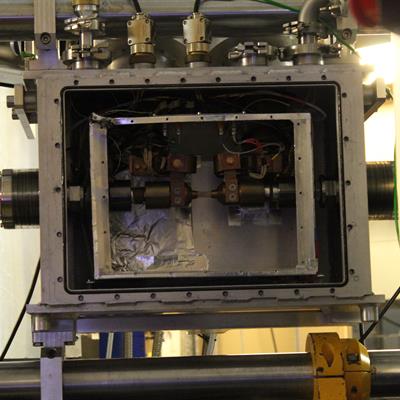Conflicts around the world have caused considerable damage to cultural heritage sites that become caught in crossfire. Despite international law protecting them, some sites have also been targeted intentionally. The effect of this damage reaches much further than the surface, and it is often being hard to tell how much the structural integrity of a building has been compromised just by looking at the outside. This internal damage could then go un-noticed, with structures rebuilt without being structurally sound.
To understand the true extent of damage requires the ability to measure how different stone compositions and conditions are affected by gunfire from various distances and angles and then apply this in the field. A research team, led by Dr Lisa Mol from University of the West of England, used the Engin-X instrument at ISIS alongside other techniques to find out what was happening under the surface of these historical monuments.
To prepare their samples, they fired bullets at sandstone blocks with a similar composition to that used for building in the Middle East and Northern Africa. Pieces were then cut from the blocks and put under 10 MPa of pressure on the beamline to replicate the weight of the rest of a building, as shown in the photograph below. As well as neutron diffraction, they also measured their samples using other geomorphological techniques such as micro-CT and resistivity.
“Our experiments showed that the damage underneath the surface goes a lot further than we thought," says Lisa. “Our results mean we can learn the relationship between what we can measure at the surface and what is actually happening to the structure inside."
Lisa's team includes Oscar Gilbert, also from University of the West of England, and Oliver Campbell, who she co-supervises with Professor Tom Blenkinsop from the University of Cardiff. With the knowledge gained from their experiments, they are investigating the effect of bullet damage on an ancient Roman theatre in Sabratha, western Libya. This World Heritage site was damaged during recent conflicts, and the Heritage in the Crossfire team that Lisa leads have worked closely with conservators in Libya to survey the building and prepare for renovation work.
 “Our work has been able to determine whether gunshot damage is just aesthetic, or if there is structural damage." Lisa adds; “Our Engin-X experiments helped us understand how the stress radiates from the impact point, and this can indicate the intensity of the damage across the rest of the structure."
“Our work has been able to determine whether gunshot damage is just aesthetic, or if there is structural damage." Lisa adds; “Our Engin-X experiments helped us understand how the stress radiates from the impact point, and this can indicate the intensity of the damage across the rest of the structure."
“The work on Sabratha has also been useful to see the effect of other conditions." Lisa explains; “the site is close to the sea, so we are able to look at what the sea spray is doing to the structure. Fractures and density loss are like magnets for moisture and salt, which can then cause further damage under the surface."
Thanks to a Royal Society grant, the next stage of the project will be to use their knowledge of bullet damage and build on it to study the damage caused by explosives, which is usually more severe. “We have to consult structural engineers to advise us how to protect the building from further damage, so we can try to minimise both future deterioration behaviour as well as structural integrity loss" Lisa adds.
In addition to their work in areas of past conflict, Lisa's team have been working closely with Blue Shield, which is an international, voluntary, organisation created and mandated under international law in 1996 to protect cultural heritage during conflict. She advises people in current conflict areas on how to do 'first aid' on buildings soon after impact and has trained army personnel to document and assess conflict damage to buildings.
“We cannot stop heritage structures being damaged in conflicts, but our aim is to work out how we deal with it to prevent further damage," she adds.
Further information
The conference paper featuring results of the work carried out at ISIS can be found in the UWE repository.
https://doi.org/10.3390/geosciences11090395
